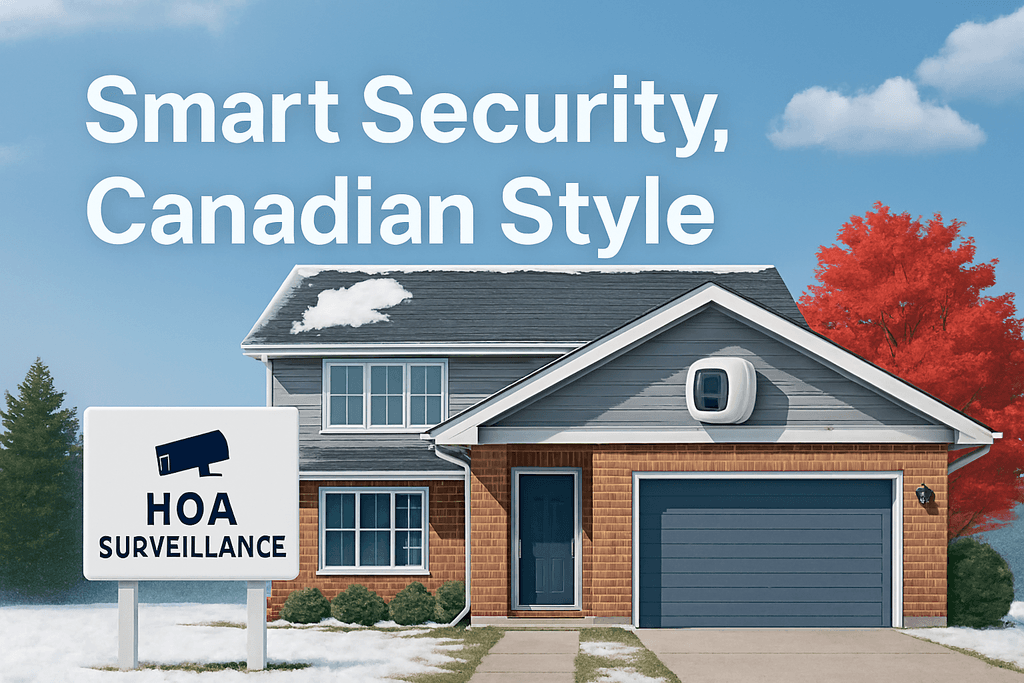Blink vs HOA Surveillance: Smart Security for Canadian Suburban Homes
Smart Security for Canadian Suburbs: Blink vs HOA Surveillance Explained
Compare Blink smart cameras with HOA surveillance systems for Canadian suburban homes. Explore privacy, coverage, cost, and legal tips to choose the best security solution for your neighborhood.
Discover the pros and cons of Blink smart cameras versus HOA-managed surveillance systems in Canadian suburban neighborhoods. Learn which setup offers better privacy, control, and coverage for your home.
Smart Security for Canadian Suburban Homes: Blink vs HOA Surveillance
As Canadian suburbs expand and evolve, so do the security needs of their residents. Homeowners are increasingly turning to smart security systems to protect their families, property, and peace of mind. Among the most popular choices are DIY smart camera systems like Blink and community-managed surveillance systems operated by Homeowners Associations (HOAs). But which is better for suburban living in Canada?
🏡 The Canadian Suburban Security Landscape
Suburban neighborhoods in Canada—from Mississauga to Burnaby—are known for their quiet streets, detached homes, and growing sense of community. But with rising concerns about porch piracy, vehicle break-ins, and property crime, homeowners are seeking affordable, flexible, and privacy-conscious security solutions.Two major options dominate the conversation:
- Blink Smart Cameras: A wireless, app-controlled security system owned by Amazon.
- HOA Surveillance Systems: Centralized camera networks managed by neighborhood associations.
📸 Blink Smart Cameras: Personalized, Portable, and Private
Blink offers a suite of wireless indoor and outdoor cameras that are easy to install and integrate with Alexa. Here’s why many Canadian homeowners prefer them:✅ Pros:
- Affordability: Blink cameras are budget-friendly, with no mandatory monthly fees.
- DIY Installation: No technician required—perfect for renters or first-time buyers.
- Cloud + Local Storage: Choose between cloud plans or USB backup.
- Privacy Control: You decide when and where to record.
- Remote Access: Monitor your home from anywhere via the Blink app.
❌ Cons:
- Limited Coverage: Only covers your property—not the whole street.
- Battery Dependency: Outdoor models require battery changes every few months.
- No Central Oversight: You’re responsible for your own footage and alerts.
🏘️ HOA Surveillance: Community-Wide Monitoring with Trade-Offs
Some Canadian neighborhoods—especially gated communities or new developments—offer HOA-managed security systems. These typically include fixed cameras at entrances, parks, and shared spaces.✅ Pros:
- Wider Coverage: Cameras monitor public areas, entrances, and sometimes sidewalks.
- Deterrence Effect: Visible cameras can discourage crime across the community.
- Shared Responsibility: Maintenance and monitoring are handled by the HOA.
❌ Cons:
- Privacy Concerns: Residents may be recorded without consent in shared spaces.
- Limited Access: Homeowners often can’t view footage unless there’s an incident.
- Costly Fees: Surveillance costs are bundled into HOA dues.
- Lack of Customization: You can’t adjust camera angles or settings.
🇨🇦 What Canadian Homeowners Should Consider
Legal Compliance: In provinces like Ontario and British Columbia, privacy laws restrict where and how you can record. Blink allows you to stay compliant by avoiding public spaces.Weather Resistance: Blink Outdoor cameras are rated for Canadian winters, but placement matters—avoid direct snow or ice exposure.
🎯 “Finally, a Setup That Doesn’t Feel Like Overkill” — Russell F.
Quote text hereI live in a quiet suburb outside Ottawa, and I didn’t want a full-blown surveillance system that felt invasive or complicated. Blink Outdoor gave me just enough coverage to monitor my front porch and backyard without turning my home into a fortress. Setup took less than 30 minutes, and I like that I can check in from my phone without dealing with HOA permissions or shared footage. It’s discreet, reliable, and doesn’t make my neighbors feel watched. For me, that’s a win.
🔐 Final Thoughts: Hybrid Security Is the Future
For many suburban Canadians, the best solution is a hybrid approach: use Blink cameras for personal property and rely on HOA systems for community-wide coverage. This ensures maximum visibility, privacy, and peace of mind.Frequently Asked Questions
Is Blink legal to use in Canadian neighborhoods with HOA surveillance?
Yes, but homeowners should ensure their cameras don’t record public or shared spaces without consent, especially in HOA-managed communities.
Can Blink cameras withstand Canadian winters?
Blink Outdoor models are weather-resistant and rated for temperatures down to -20°C, but placement under eaves or sheltered areas is recommended.
Do HOA surveillance systems replace personal security cameras?
Not entirely. HOA systems monitor shared areas, but personal cameras like Blink offer coverage for private property and entryways.
What’s the difference between cloud and local storage for Blink?
Cloud storage requires a subscription, while local storage uses a USB drive with the Blink Sync Module 2—ideal for privacy-focused users.
Product Comparison
| Feature | Product 1 | Product 2 | Product 3 |
|---|---|---|---|
| Feature | Blink Outdoor 4 | Arlo Pro 5S | EufyCam 3C |
| Video Resolution | 1080p HD | 1080p HD | 1080p HD |
| Power Source | AA Lithium Batteries | Rechargeable Battery | Built-in Battery |
| Storage Options | Cloud + Local (USB) | Cloud + Local (microSD) | Local (HomeBase) + Cloud |
| Weather Resistance | IP65 (Rain/Snow) | IP67 (Heavy Rain/Snow) | IP67 |
| Smart Integration | Alexa | Alexa, Google, Apple HomeKit | Alexa, Google |
| Subscription Needed | Optional | Optional | Optional |
| Field of View | 110° | 160° | 135° |
| Price Range (CAD) | ~$130 | ~$250 | ~$200 |
